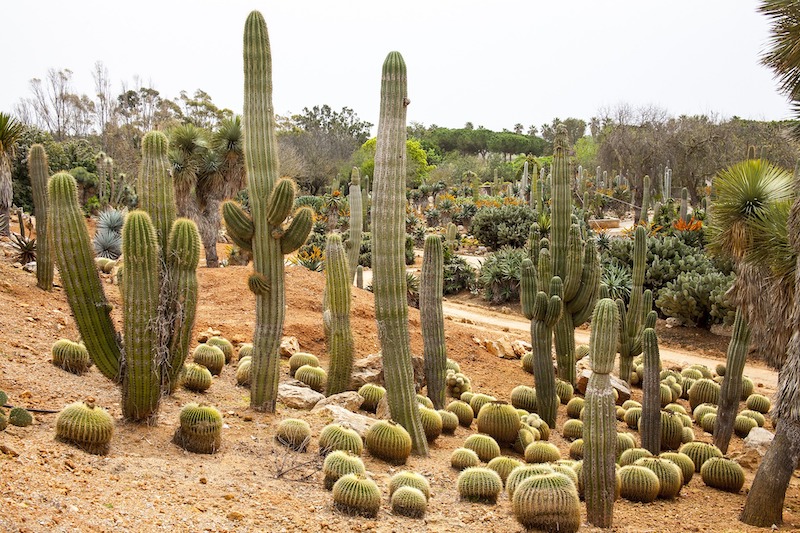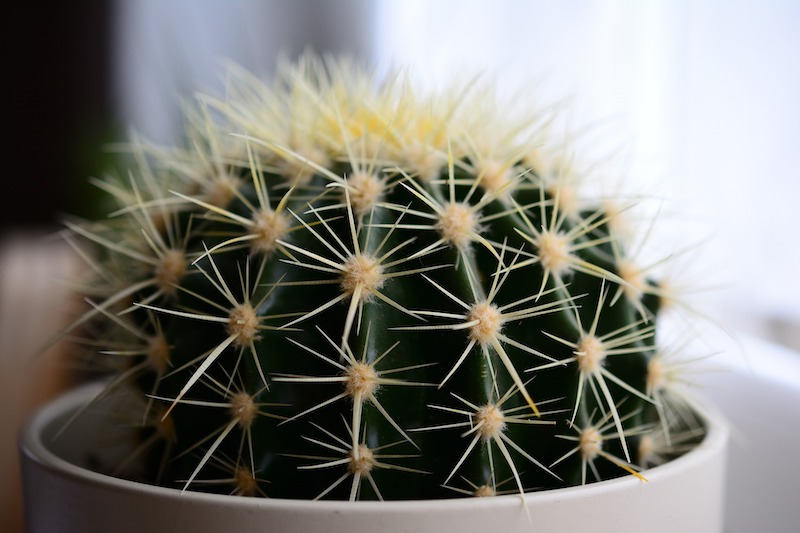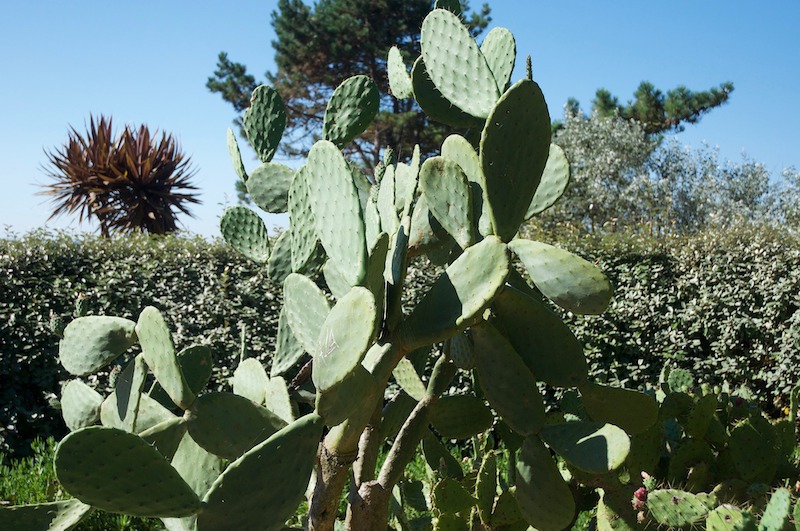Growing Cactus
Cacti are a diverse group of succulents classified in the plant family Cactaceae, all native to regions in North and South America. With thousands of species, this family contains both desert cacti and forest cacti. Desert cacti generate the most well-known image of a cactus: tall or rounded green plants covered in sharp spines. Some common genera of cacti for indoor gardens are Opuntia sp. (prickly pear or bunny ears cactus), Echinocactus sp. (golden barrel cactus), and Cephalocereus sp. (old man cactus).
Forest cacti are represented in the houseplant scene by Schlumbergera sp., better known as Christmas or Thanksgiving cacti. Both desert and forest cacti have spectacular flowers, blooming in shades of white, red, orange, pink, and yellow. The cactus family is highly variable, ranging in size from a few inches tall to over 60 feet high in their native environment. These slow-growing plants are ideal for beginners and collectors to care for, providing low-maintenance interest to your home.

Cactus Sunlight Requirements
Cacti require bright indirect to bright direct light. South- or west-facing windows work well for positioning cacti. Most species of cacti need at least 6 hours of sunlight per day. When sunlight is more intense in the summer, keep cacti out of direct light to prevent scorching. Direct light is tolerated by most cacti throughout the winter months. Forest cacti can tolerate lower light levels, as their native environment is shady tropical rainforests. Cacti rely on seasonal light cues to bloom, so be sure that they receive consistent light. A lack of light will lead to etiolated, weak growth that can result in plants breaking or falling over.
Planting Cactus
Use a commercially available cacti potting mix to plant your cacti in. These mixes are formulated to drain well, simulating the sandy soil of their native environment. If needed, a small amount of peat moss can be added to achieve a more acidic soil that cacti thrive in. Since cacti are slow to grow, repotting every 3-4 years is sufficient. Select a pot that is about 1-2 inches wider than the plant’s current pot. Clay or terracotta pots are recommended for cacti, as they are more porous in nature, allowing better exchange of air while releasing excess moisture. When potting or transplanting cacti, wear thick gloves to protect you from the spines. Be especially careful when handling cacti of the Opuntia genus, as these plants grow glochids – tiny, hair-like spines that readily lodge into skin.

Watering Cactus
Cacti are succulent plants that store water in specialized cells called parenchyma. As such, most cacti will not need to be watered as often as other indoor plants. During the active growing season of spring and summer, cacti should be watered every 10-14 days, sometimes less. In winter and fall, reduce watering to just every 4-6 weeks. Cacti that are dehydrated will develop a prune-like, wrinkled texture. Overwatered cacti are prone to rot, with black, squishy bases of stems oozing water. When watering a cactus, set the pot in a sink or container filled with a few inches of water for 30 minutes, allowing water to enter through the pot’s drainage hole. Let the soil dry out completely before soaking or watering again. Forest cacti will need to be watered more often than desert cacti, about 1-2 times a week or anytime the soil is completely dry. Average household humidity is plenty for most cacti.
Fertilizing Cactus
Cacti grow in nutrient-poor, sandy soils throughout most of their native range. They are highly adapted to harsh conditions that many other plants would not survive. Because of this, cacti do not require frequent fertilization. If desired, cacti can be fertilized just once per year in spring or summer. Select a liquid fertilizer that favors phosphorus and is low in nitrogen. A standard 10-10-10 formula works well too. Dilute the fertilizer to one-half or one-third of the recommended strength.
Common Cactus Problems
Yellowed, brown, or mushy leaves are often caused by over or underwatering. Check for signs of rot, as well as the soil moisture levels. Adjust and repot accordingly. Squishy, wilted tissue may also be caused by cold damage due to cell expansion in the cactus. Carefully prune off any damaged areas and move your cactus to a warm location without any drafts. Common pests of cacti include mealybugs, scale, and spider mites, which can be sprayed off with water or horticultural oil. If your cactus is not blooming, it may be due to a mixture of factors such as light and temperature. Make sure your cactus is in a warm, bright location that receives 6-8 hours of sunlight at around 70°F and cool night temperatures around 55°F. Root-bound plants are more likely to bloom than plants with plenty of room to grow, as more energy will be put towards flower versus root production. Proper dormancy through winter will also encourage flowers; move your cactus to a cool location and water it less often. Some cacti will never flower in a home environment due to age. Forest cacti require long nights of 12-14 hours to initiate blooms.
Propagating Cactus
Many cacti will produce offshoots at the base of the mother plant. These offshoots can be cut entirely from the mother plant and allowed to callus over for several days before planting in fresh, slightly moistened soil. Other cacti produce pads, which are offshoots of the flat, green stems. These offshoots can be taken from the main plant with gloves or tongs and a knife, and propagated using the same methods as the basal offshoots above. Sometimes it is helpful to lay the pads flat rather than upright to prevent them from falling over. For all cacti cuttings, rooting hormone will greatly increase the success of propagation. Cacti can also be propagated by seed, though it requires patience. Many species of cacti have seeds that require stratification: using a cold-moist treatment to break the dormancy. To do this, put the seeds in a bag or container of moistened, sterile media. Label the bag and place in your refrigerator for roughly 4-8 weeks, depending on the species. Once the stratification process is complete, plant the seeds in a cacti mix and lightly cover them with soil. Move them to a bright, warm location where they will germinate after several weeks.

Growing Cactus Outdoors
Cacti can be moved outdoors in the summer when night temperatures are consistently above 50°F. These plants thrive in warm temperatures of 70°F-80°F with full sun. Be sure to acclimate your cacti to the harsher outdoor sun by gradually exposing it to direct sun a few hours at a time. Forest cacti will need partial or dappled shade. Water your cacti infrequently, especially when there has been precipitation. In warmer, desert regions, cacti can be grown in the ground as perennials in sandy, rocky soils. There are a few species of cacti that are native perennials in temperate North America, most notably Opuntia humifusa. This is an excellent plant for gardeners in colder regions who wish to grow cacti outdoors year-round.
 |
Lauren Youngcourt - Published 03-01-2023 |
